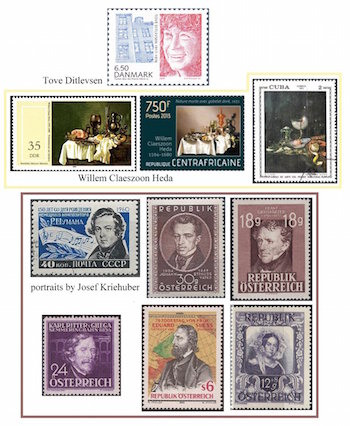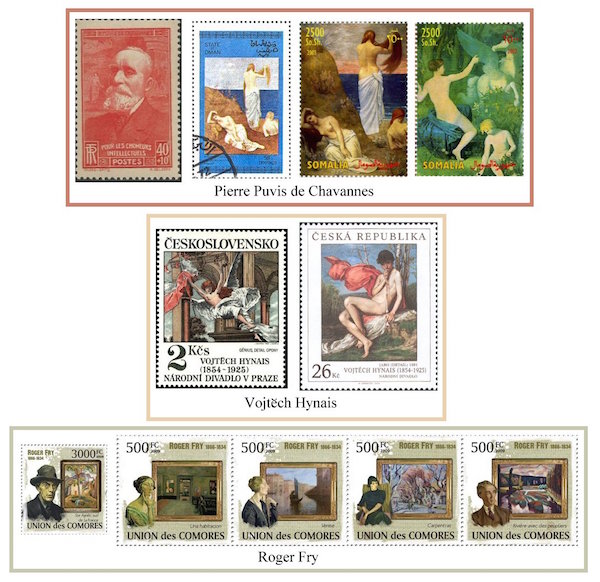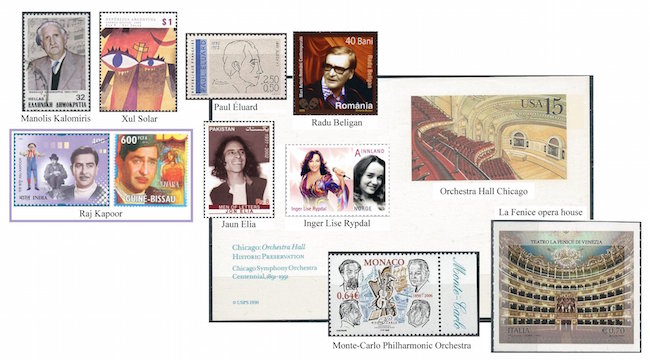The Arts on Stamps of the World — December 14
An Arts Fuse regular feature: the arts on stamps of the world.

By Doug Briscoe
As we have no household names today (Roger Fry and Paul Élouard come closest), let’s begin with a centenary celebration. Today is the 100th anniversary of the birth of Danish poet Tove Ditlevsen (14 December 1917 – 7 March 1976), whose thirty books range from poetry to novels to short story collections to memoirs. Much of her work is centered on her life growing up in a working-class neighborhood of Copenhagen. Married and divorced four times, Ditlevsen took her own life with an overdose of sleeping pills.
Our next five people are all visual artists. Dutch painter of exquisite still lifes
Willem Claeszoon Heda (December 14, 1593/1594 – c. 1680/1682) was born and died in Haarlem. He had an uncle who was also a painter. I found three Hedas on stamps with links to two of them, the Breakfast Setting with Ham on the East German stamp and Still Life with Golden Goblet (1635) on one from the CAR. I couldn’t find the one on the Cuban issue and offer as a tasty substitute Breakfast Table with Blackberry Pie (mm!) (1631).

We pass over two centuries to come to the Austrian lithographer Josef Kriehuber (14 December 1800 – 30 May 1876), among whose 3000 works we find portraits of many famous persons of his day, and these prints have served Austrian and other postal services very well, as we shall see. Kriehuber was born and died in Vienna. He attended the Imperial Academy from the age of 13. At 17 he accompanied a prince on a journey to Poland as a drawing-master and while in Galicia made a specialty of painting horses. Back in Vienna he worked for several publishing houses and also produced a body of work reflecting the city’s popular Prater park. With the advent of of photography, Kriehuber’s talents found fewer clients, and he died in poverty. He is one of the many distinguished persons to be buried in the famous Zentralfriedhof. Among his many sitters are ones whose stamps we’ve already seen in these pages, such as the composers Robert Schumann and Johann Strauss the Elder and the poet Franz Grillparzer. (These links lead to Kriehuber’s lithographs, not to our own Arts Fuse articles on those artists.) By the way, a famous portrait of the dashing young Liszt has apparently not made its way to a stamp yet. A few portraits we would not otherwise see here on AoSotW are of railway builder Carl Ritter von Ghega and geologist Eduard Suess. One Austrian stamp also shows a portrait of an anonymous woman. And yet, despite having provided stamp designers with so much material, Kriehuber himself has yet to be honored philatelically.
French painter Pierre Puvis de Chavannes (14 December 1824 – 24 October 1898) planned to follow his father as a mining engineer but was sidetracked by an illness, and after a trip to Italy decided to become a painter. One of his first teachers, albeit only for a short time, was Eugène Delacroix. He exhibited four paintings at the 1850 Paris Salon. In Montmartre he had an affair with Suzanne Valadon, painter and mother of Utrillo (whose birthday comes at the end of the month). (We shall hear more of Valadon in our next paragraph.) Puvis de Chavannes had a much longer lasting amour (40 years) with the Romanian princess Marie Cantacuzène. He did so much work as a muralist that he came to be called “the painter for France”. Toward the end of his life he was a co-founder and served as president of the Société Nationale des Beaux-Arts (National Society of Fine Arts). Puvis de Chavannes was honored on a French stamp back in 1939. His Young Girls by the Seaside (dated by various sources as 1879 or 1887 or 1894, take your pick) is seen on stamps from Oman and Somalia, with Fantasy (1866) appearing on another stamp from the Somalia set.
The Czech painter Vojtěch Hynais (1854 – 22 August 1925) was born in Vienna and studied under Anselm Feuerbach, who regarded Hynais as one of his finest pupils. They traveled together to Italy in 1877. The next year Hynais continued his studies Paris, learning from Jean-Léon Gérôme, becoming acquainted with Alphonse Mucha, and getting married. While still in Paris, Hynais made sketches for the curtain (1883) for a new Prague National Theater. A small detail from this work, representing Genius in allegory, is shown on the first of the two Czech stamps. The model for the figure was none other than Suzanne Valadon (see above). Back in Paris, Hynais’ work claimed a first-class medal at the 1889 World’s Fair, and he earned another at the Antwerp World’s Fair of 1894. The artist’s other curriculum vitae include working for the Sèvres porcelain firm (1889-92), accepting a professorship at the Prague Academy of Fine Arts (1894), becoming one of the co-founders of the Vienna Secession, and receiving the Legion of Honor in 1923. The second Czech stamp shows a detail from his Spring, and here is a link to his 1892 Judgement of Paris.
The English painter and important art critic Roger Fry (14 December 1866 – 9 September 1934) was introduced into the Bloomsbury Group through Vanessa and Clive Bell. He began an affair with her in 1911 (his wife had been committed to a mental institution in 1910). At this time Fry was also co-editor of The Burlington Magazine, Britain’s first scholarly art history periodical. A year earlier he had organized the exhibition that introduced Manet, Gauguin, Matisse, and Van Gogh to a wider British public. It was also Fry who coined the term Post-Impressionists. For his stamps we must go to two minisheets, from which I have extracted the stamps, from the Comoros Islands. Each of the stamps cleverly combines one of Fry’s portraits with one of his landscapes or other paintings. So we begin with the Self-Portrait of 1928 (he did several), paired with Ste Agnès, South of France (1915). The next two stamps show two portraits of Edith Sitwell, the first from 1915 and the second from 1918. Their accompanying paintings are A Room at the Second Post-Impressionist Exhibition, Matisse Room (1912, this has also been attributed to Vanessa Bell) and Venice. Portrait Of Nina Hamnett (1917) is matched with Carpentras (1930), and the final double image is of Portrait of Bertrand Russell (c1923) and River with Poplars (c1912). After Fry’s sudden death from a fall in his home, Virginia Woolf was asked to write his biography (1940). Here is Fry’s portrait of her. Fry also wrote numerous books on art (e.g., Giovanni Bellini [1899], Cézanne. A Study of His Development [1927], Reflections on British Painting [1934]) and made a translation of the poems of Stéphane Mallarmé.

Manolis Kalomiris (December 14, 1883 – April 3, 1962) was a Greek composer, regarded as the originator of the Greek national school of music. He founded two conservatories, the Hellenic in 1919 and the National in 1926. Kalomiris wrote three symphonies and five operas, one piano concerto and one for violin, other symphonic works, chamber music, and numerous songs and piano works besides writing pedagogical treatises.
Quite a character was this Xul Solar (December 14, 1887 – April 9, 1963). First of all, there’s his name. Born Oscar Agustín Alejandro Schulz Solari in Buenos Aires, he adapted the name of his Baltic German father, Schulz, into the sound equivalent Xul, which, spelled backwards, is Latin for “light”. To this he appended his Italian mother’s name of Solari, dropping the final “i” so that he became The Light of the Sun. Then, no surprise, he was fascinated with astrology and reincarnation. Then there’s the matter of his having invented two languages, Neo Criollo, an amalgam of Portuguese and Spanish, and Pan Lingua, which was supposed to combine not only language but also mathematics, music, astrology, and the visual arts. Hermann Hesse‘s “glass bead game” comes to mind, and sure enough, Solar invented a game based on chess that he called “panchess” (Panajedrez), of which he claimed to be world champion. Yet one assumes he can’t have been a complete crackpot, as he was a close friend of Jorge Luis Borges. (Solar figures as a character in “Tlön, Uqbar, Orbis Tertius”.) But let’s get to the art. He studied music first, then architecture. He worked as a schoolteacher (those must have been some fun sessions) and, towards the end of World War I, at the Argentine consulate in Milan. It was in that city that he held his first major exhibition in 1920 along with his colleague the sculptor Arturo Martini. He came back to Buenos Aires in 1924 and for the rest of his life had plentiful exhibits there and in Montevideo, but no more in Europe until just before his death, when a major retrospective was held in Paris. He was honored on an Argentine stamp in 2003 with part of his San P. (1923).
French poet Paul Éluard (1895 – 18 November 1952) had what sounds very much like a movie script sort of life beginning with a Zhivago/Lara sort of romance. At 16, he fell ill with tuberculosis and had to be hospitalized at a sanatorium near Davos where he met a girl he called Gala (her real name was Helena Diakonova). To borrow language from advertising, “Against a background of war their love story unfolds…” After both teenagers were well enough to return home—but were thus cruelly separated—Gala took it upon herself to return to France via Helsinki, Stockholm, London, Southampton, and Dieppe. They married on 20 February 1918. (In the meantime, Éluard had been serving in World War I, so we can throw in a few action sequences.) Three months after their wedding, Gala gave birth to a baby girl who would live to be almost a centenarian (the whole thing could be told in flashbacks!). In 1921 the couple visited Max Ernst and formed a ménage à trois (Ernst having entered France illegally by using Éluard’s passport—shadowy scenes of intrigue and avoiding border guards). After a fashion (obligatory nude scenes), Paul decided he was no longer happy with the arrangement and disappeared. Months later, Gala found him in Saigon (the mysterious East, smoky opium dens, menacing Asians with long mustachios). Next year, Éluard became a supporter of the Moroccan revolution (more guns!) and in 1927 joined the Communist Party (Reds!) along with fellow artists Louis Aragon, André Breton, and others. In 1928 he suffered a recurrence of his tuberculosis (tell-tale, ominous coughing and bloodied handkerchiefs) and went back to the sanatorium. Gala accompanied him, but soon ran off with Salvador Dalí (torrid romance, betrayal)! Well, after all this turmoil, it seems Éluard found some peace and contentment in his 1934 marriage to Maria Benz, called “Nusch”, a music-hall performer to whom he had been introduced by his wacky chums Man Ray and Pablo Picasso (comic relief). But the drama resumed with the coming of another war (strains of “Deutschland über alles” in a minor key), and Éluard faked insanity in an asylum (Grand Guignol-type screaming, wild-eyed maniacs) where perfectly sane Jews and other resisters were hiding out. From nail-biting suspense to heartbreaking tragedy as we learn of the early death of Nusch in 1946, then, Éluard, clamping a cigarette between his teeth, went off to fight in the Greek Civil War…for a few days. In Budapest he took part in celebrations marking the centenary of the death of Sándor Petőfi (festive crowds, fireworks, wine). While there he met Pablo Neruda (played by a CGI Philipp Noiret).While attending a peace conference in Mexico he met his third wife. Back in France, Éluard wrote in praise of Stalin and died of a heart attack. The government would have no part in his funeral, so the Communist Party took care of it. Oh yes, along the way, Éluard also wrote some poems. He was a particular inspiration for Francis Poulenc, who wrote three song cycles to Éluard’s words. Other composers who have set Éluard’s poetry include Georges Auric, Mikis Theodorakis, film music composer Georges Delerue, Clermont Pépin, Ferenc Farkas (his birthday is tomorrow), Dinu Lipatti (!), and Finns Einojuhani Rautavaara and Kaija Saariaho (whose opera L’amour de loin was just given last season at the Met). Saariaho’s Éluard piece is called “Grammaire des rêves” (From the Grammar of Dreams, 1988) and is scored for for soprano, alto, and chamber ensemble.
Romanian actor Radu Beligan (14 December 1918 – 20 July 2016) was named by Guinness World Records as “the oldest active theater actor” in the world the day after his 95th birthday. (He lived another four and a half years.) Beligan studied in Bucharest under the Grande Dame of Romanian theater Lucia Sturdza-Bulandra. Over the next seventy years he went on to perform in the great works of the repertoire, including those of his colleague Eugène Ionescu. He also appeared in many Romanian movies.

One of the great stars of Hindi cinema was Raj Kapoor (14 December 1924 – 2 June 1988), who came from a noted family of filmmakers. He started acting in movies at age ten, and as an adult came to fame in Neel Kamal (1947), when he played opposite Madhubala, who was appearing in her first leading role. The next year he founded his own studio, R. K. Films, and began directing. In a series of films he created a character modeled on Charlie Chaplin‘s Tramp. Nevertheless (?), he came to be known as “the Clark Gable of the Indian film industry”. His performances were twice nominated for the Palme d’Or at Cannes. A Time magazine piece named his work in Awaara (1951) one of the top ten performances in film history. India Post put him on a stamp in 2001, and Guinea-Bissau followed suit in 2010.
Pakistani poet Jaun Elia (14 December 1931 – 8 November 2002) was fluent in Urdu, Arabic, English, Persian, Sanskrit, and Hebrew. He wrote his poems in Urdu. Elia was born in Uttar Pradesh to a man conversant with art and literature. Elia wrote all his life but resisted publishing until he was 60 years old. A further five volumes of poetry came out posthumously. A Communist, Elia described himself as an agnostic, a migrant, and an anarchist.
Norwegian singer and actress Inger Lise Rypdal (born 14 December 1949) has diversified in genre—pop, rock, and musical—and has acted on stage and in film. She was married to guitarist and composer Terje Rypdal from 1969 to 1985. She has made 16 albums in Norway and a few more in Sweden and has appeared in nine movies.
This date also gives us occasion to discuss two music halls. Orchestra Hall Chicago was built in 1904 as a home for the Chicago Symphony Orchestra. The first concert was held on December 14 of that year. In 1990 the US Postal Service issued this card as part of a series celebrating the preservation of historic buildings.
The new La Fenice opera house opened on 14 December 2003 with an inaugural concert of Beethoven, Wagner, and Stravinsky. (The first opera staged in the new hall, La traviata, was not given until the following year.) The stamp marks the tenth anniversary of the event.
Also, the Monte-Carlo Philharmonic Orchestra gave its first concert on this date in 1856. The stamp, from 2006, depicts the four princes of Monaco who reigned in the principality over those 150 years. (Actually, Prince Rainier III died on 6 April 2005 and was succeeded by his son Albert II.)
We give a nod, but no stamp, to Shirley Jackson (December 14, 1916 – August 8, 1965) and English military historian Sir Antony Beevor (born 14 December 1946).
A graduate of the University of Massachusetts with a B.A. in English, Doug Briscoe worked in Boston classical music radio, at WCRB, WGBH, and WBUR, for about 25 years, beginning in 1977. He has the curious distinction of having succeeded Robert J. Lurtsema twice, first as host of WGBH’s weekday morning classical music program in 1993, then as host of the weekend program when Robert J.’s health failed in 2000. Doug also wrote liner notes for several of the late Gunther Schuller’s GM Recordings releases as well as program notes for the Boston Classical Orchestra. For the past few years he’s been posting a Facebook “blog” of classical music on stamps of the world, which has now been expanded to encompass all the arts for The Arts Fuse.

Paul Eluard was one of the 2 or 3 greatest poets of the last century. What you write about him sounds ridiculous.